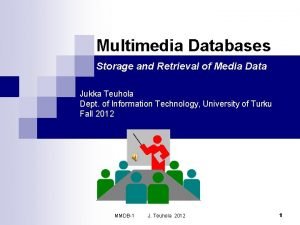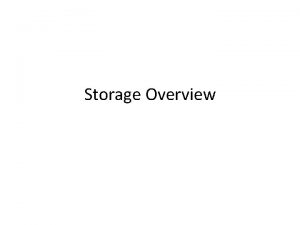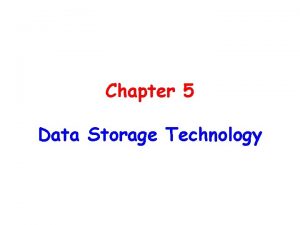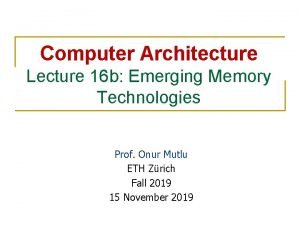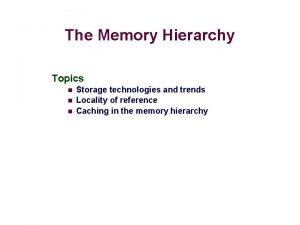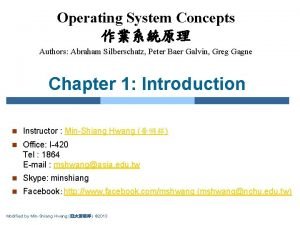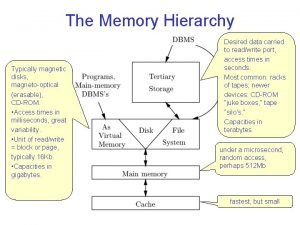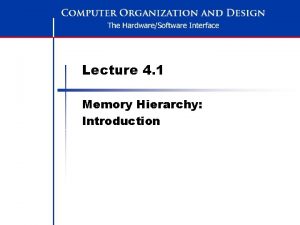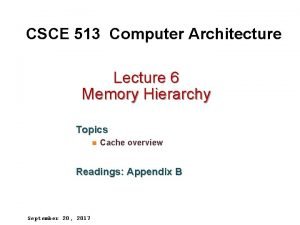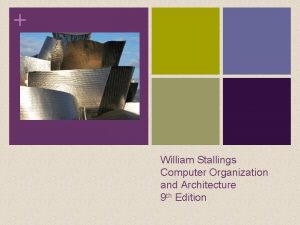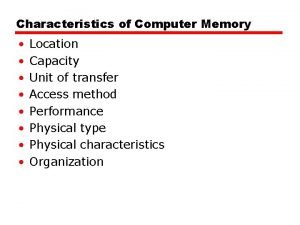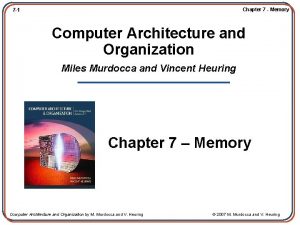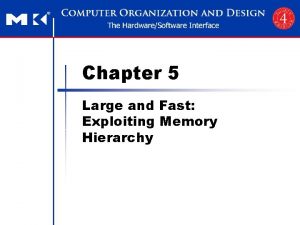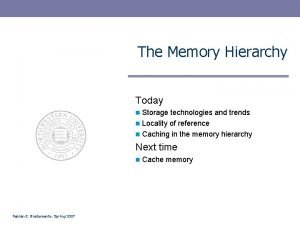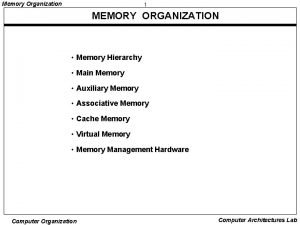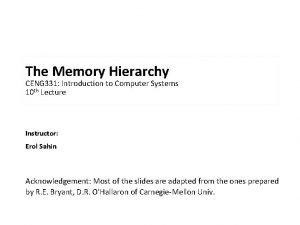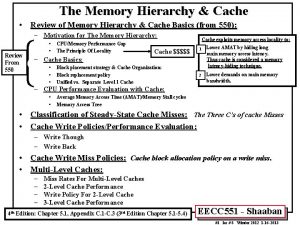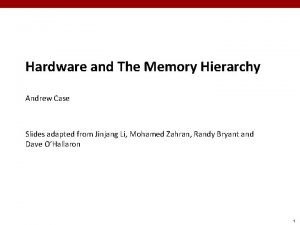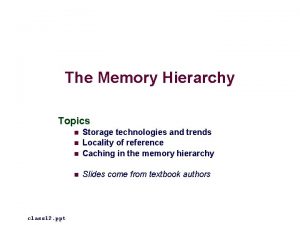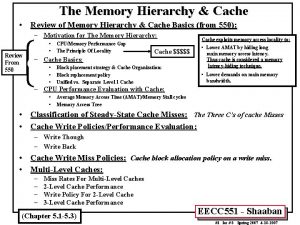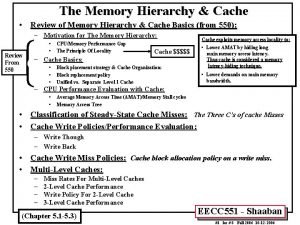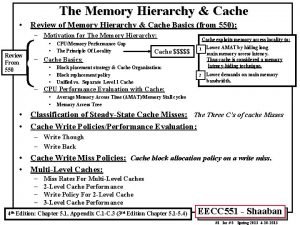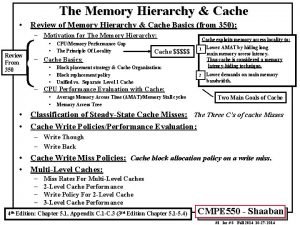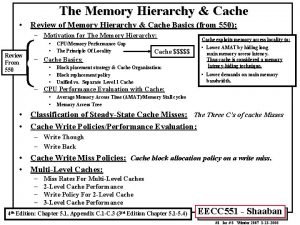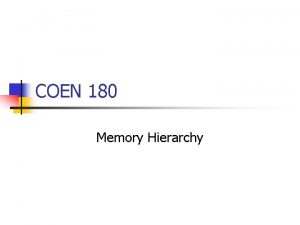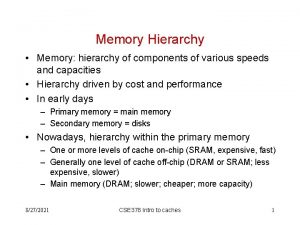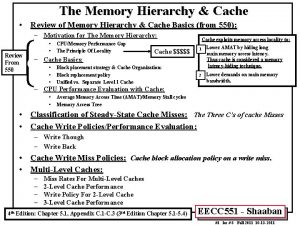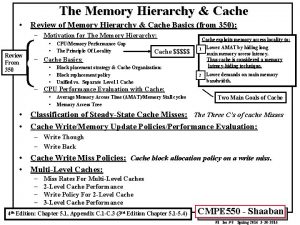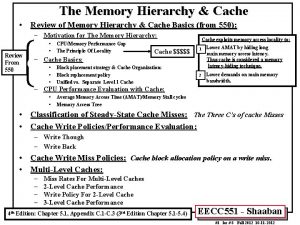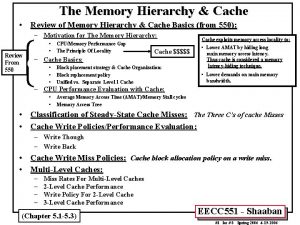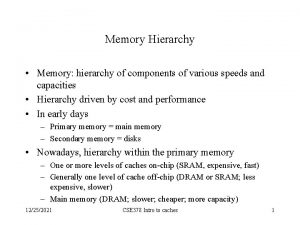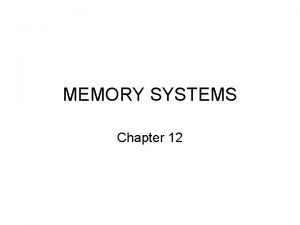Chapter 6 The Memory Hierarchy Topics Storage technologies












































![Locality Example #1 int sum_array_rows(int a[M][N]) { int i, j, sum = 0; } Locality Example #1 int sum_array_rows(int a[M][N]) { int i, j, sum = 0; }](https://slidetodoc.com/presentation_image_h/8d91aab1c51483695602388d2ed3afc4/image-45.jpg)
![Locality Example #2 int sum_array_cols(int a[M][N]) { int i, j, sum = 0; } Locality Example #2 int sum_array_cols(int a[M][N]) { int i, j, sum = 0; }](https://slidetodoc.com/presentation_image_h/8d91aab1c51483695602388d2ed3afc4/image-46.jpg)
![Locality Example #3 int sum_array_3 d(int a[M][N][N]) { int i, j, k, sum = Locality Example #3 int sum_array_3 d(int a[M][N][N]) { int i, j, k, sum =](https://slidetodoc.com/presentation_image_h/8d91aab1c51483695602388d2ed3afc4/image-47.jpg)




- Slides: 51

Chapter 6: The Memory Hierarchy ¢ Topics § § § Storage technologies and trends Locality of reference Caching in the memory hierarchy Cache design principles Implications of caches for programmers

Administrivia ¢ ¢ ¢ Skipping most of chapter 5, come back later Lab 7 this week, final VHDL lab, functional CPU Lab 8 and after, lab 365 HW 7 -8, final buffer overflow exercise Reading chapter 6

Where are we? ¢ ¢ ¢ C, assembly, machine code Compiler, assembler CPU design Pipeline Up coming lectures § § § Memory architecture Cache Virtual memory I/O, interrupts Modern CPU, parallelism, performance

Amdahl’s Law Original execution time New execution time Timeold α 1 -α An enhancement reduces execution time of blue fraction by a factor of k. Timenew k is speeduppart Timenew = (1 - α) Timeold + (α) Timeold / k = Timeold [(1 - α) + α/k] Speedupoverall = Timeold Timenew = 1 (1 - α) + α/k

Applying Amdahl’s Law 1. You’re trying to speed up a program, and you cut the execution time of function A by ½. If A accounted for ½ the original execution time, what overall speedup will you get from your improvement to A? 2. You’re trying to save money, so you decide to cut your purchases of lottery tickets down by 80%. If, after making this change, just 10% of your budget goes for lottery tickets, by what factor did you reduce your overall expenditures? 3. You’re trying to get some computationally intense code to run faster on a supercomputer with 100 processors. Part of the code is inherently serial, and the rest is parallelizable. What fraction of the code must be fully parallelized to get 10 x speedup? Speedupoverall = Timeold Timenew = 1 (1 - α) + α/k

Random-Access Memory (RAM) ¢ ¢ ¢ Key features § RAM is packaged as a chip. § Basic storage unit is a cell (one bit per cell). § Multiple RAM chips form a memory. Static RAM (SRAM) § Each cell stores bit with a six-transistor circuit. § Retains value indefinitely, as long as it is kept powered. § Relatively insensitive to disturbances such as electrical noise. § Faster, more expensive, and larger than DRAM. Dynamic RAM (DRAM) § Each cell stores bit with a capacitor and transistor. § Value must be refreshed every 10 -100 ms. § Sensitive to disturbances. § Slower, cheaper, and smaller than SRAM.

SRAM vs DRAM Summary Access time Persist? Sensitive? Cost Applications SRAM 1 X Yes No 100 x Cache memories DRAM 10 X No Yes 1 X Main memories, frame buffers

Conventional DRAM Organization ¢ d x w DRAM: § dw total bits organized as d supercells of size w bits 16 x 8 DRAM chip (128 bits total) 0 2 bits / 2 3 0 addr (to CPU) 1 cols 1 rows memory controller supercell (2, 1) 2 8 bits / 3 data internal row buffer

Reading DRAM Supercell (2, 1) ¢ Step 1(a): Row access strobe (RAS) selects row 2. Step 1(b): Row 2 copied from DRAM array to row buffer. 16 x 8 DRAM chip 0 RAS = 2 2 / 1 cols 2 3 0 addr 1 rows memory controller 2 8 / 3 data internal row buffer

Reading DRAM Supercell (2, 1) ¢ Step 2(a): Column access strobe (CAS) selects column 1. Step 2(b): Supercell (2, 1) copied from buffer to data lines, and eventually back to the CPU. 16 x 8 DRAM chip 0 CAS = 1 2 / 2 3 0 addr To CPU 1 rows memory controller supercell (2, 1) 1 cols 2 8 / 3 data supercell (2, 1) internal row buffer

Memory Modules addr (row = i, col = j) : supercell (i, j) DRAM 0 64 MB memory module consisting of eight 8 Mx 8 DRAMs DRAM 7 bits bits 56 -63 48 -55 40 -47 32 -39 24 -31 16 -23 8 -15 63 56 55 48 47 40 39 32 31 24 23 16 15 8 7 bits 0 -7 0 64 -bit doubleword at main memory address A 64 -bit doubleword Memory controller

Enhanced DRAMs ¢ All enhanced DRAMs are built around the conventional DRAM core. § Fast page mode DRAM (FPM DRAM) Access contents of row with [RAS, CAS, CAS] instead of [(RAS, CAS), (RAS, CAS)]. Extended data out DRAM (EDO DRAM) § Enhanced FPM DRAM with more closely spaced CAS signals. Synchronous DRAM (SDRAM) § Driven with rising clock edge instead of asynchronous control signals. Double data-rate synchronous DRAM (DDR SDRAM) § Enhancement of SDRAM that uses both clock edges as control signals. Video RAM (VRAM) § Like FPM DRAM, but output is produced by shifting row buffer § Dual ported (allows concurrent reads and writes) § § §

Nonvolatile Memories ¢ ¢ DRAM and SRAM are volatile memories. § Lose information if powered off. Nonvolatile memories retain value even if powered off. § Generic name is read-only memory (ROM). § Misleading because some ROMs can be read and modified. Types of ROM/nonvolatile memory § Programmable ROM (PROM) § Erasable programmable ROM (EPROM) § Electrically erasable PROM (EEPROM) § Flash memory Firmware § Program stored in a ROM Boot time code, BIOS (basic input/output system) § Graphics cards, disk controllers, embedded devices §

Typical Bus Structure Connecting CPU and Memory ¢ ¢ A bus is a collection of parallel wires that carry address, data, and control signals. Buses are typically shared by multiple devices. CPU chip register file ALU system bus interface I/O bridge memory controller, etc. memory bus main memory

Memory Read Transaction (1) ¢ CPU places address A on the memory bus. register file %eax Load operation: movl A, %eax ALU I/O bridge bus interface A main memory 0 x A

Memory Read Transaction (2) ¢ Main memory reads A from the memory bus, retrieves word x, and places it on the bus. register file %eax Load operation: movl A, %eax ALU I/O bridge bus interface x main memory 0 x A

Memory Read Transaction (3) ¢ CPU reads word x from the bus and copies it into register %eax. register file %eax x Load operation: movl A, %eax ALU I/O bridge bus interface main memory 0 x A

Memory Write Transaction (1) ¢ CPU places address A on bus. Main memory reads it and waits for the corresponding data word to arrive. register file %eax y Store operation: movl %eax, A ALU I/O bridge bus interface A main memory 0 A

Memory Write Transaction (2) ¢ CPU places data word y on the bus. register file %eax y Store operation: movl %eax, A ALU I/O bridge bus interface y main memory 0 A

Memory Write Transaction (3) ¢ Main memory reads data word y from the bus and stores it at address A. register file %eax y Store operation: movl %eax, A ALU I/O bridge bus interface main memory 0 y A

Disk Geometry ¢ ¢ ¢ Disks consist of platters, each with two surfaces. Each surface consists of concentric rings called tracks. Each track consists of sectors separated by gaps. tracks surface track k spindle sectors gaps

Disk Operation (Single-Platter View) The disk surface spins at a fixed rotational rate The read/write head is attached to the end of the arm and flies over the disk surface on a thin cushion of air. spindle By moving radially, the arm can position the read/write head over any track.

Disk Geometry (Multiple-Platter View) ¢ Aligned tracks form a cylinder k surface 0 read/write heads move in unison from cylinder to cylinder platter 0 surface 1 surface 2 arm platter 1 surface 3 surface 4 platter 2 surface 5 spindle

Disk Capacity ¢ ¢ Capacity: maximum number of bits that can be stored. § Vendors express capacity in units of gigabytes (GB), where 1 GB = 10^9. Capacity is determined by these technology factors: § Recording density (bits/in): number of bits that can be squeezed into a 1 inch segment of a track. § Track density (tracks/in): number of tracks that can be squeezed into a 1 inch radial segment. § Areal density (bits/in 2): product of recording and track density. ¢ Modern disks partition tracks into disjoint subsets called recording zones § Each track in a zone has the same number of sectors, determined by the circumference of innermost track. § Each zone has a different number of sectors/track § Contrast with old approach: fixed number of sectors for all tracks

Computing Disk Capacity = (# bytes/sector) x (avg. # sectors/track) x (# tracks/surface) x (# surfaces/platter) x (# platters/disk) ¢ Example: § 512 bytes/sector § 300 sectors/track (averaged across all tracks) § 20, 000 tracks/surface § 2 surfaces/platter § 5 platters/disk Capacity = 512 x 300 x 20000 x 2 x 5 = 30, 720, 000 = 30. 72 GB

Disk Access Time ¢ ¢ Average time to access some target sector approximated by : § Taccess = Tavg seek + Tavg rotation + Tavg transfer Seek time (Tavg seek) § Time to position heads over cylinder containing target sector. § Typical Tavg seek = 9 ms Rotational latency (Tavg rotation) § Time waiting for first bit of target sector to pass under r/w head. § Tavg rotation = 1/2 x 1/RPMs x 60 sec/1 min Transfer time (Tavg transfer) § Time to read the bits in the target sector. § Tavg transfer = 1/RPM x 1/(avg # sectors/track) x 60 secs/1 min.

Disk Access Time Example ¢ ¢ Given: § Rotational rate = 7, 200 RPM § Average seek time = 9 ms. § Avg # sectors/track = 400. Derived: § Tavg rotation = ? § Tavg transfer = ? § Taccess = ?

Disk Access Time Example ¢ ¢ Given: § Rotational rate = 7, 200 RPM § Average seek time = 9 ms. § Avg # sectors/track = 400. Derived: § Tavg rotation = 1/2 x (60 secs/7200 RPM) x 1000 ms/sec = 4 ms. § Tavg transfer = 60/7200 RPM x 1/400 secs/track x 1000 ms/sec = 0. 02 ms § Taccess = 9 ms + 4 ms + 0. 02 ms

Disk Access Time Example ¢ ¢ ¢ Given: § Rotational rate = 7, 200 RPM § Average seek time = 9 ms. § Avg # sectors/track = 400. Derived: § Tavg rotation = 1/2 x (60 secs/7200 RPM) x 1000 ms/sec = 4 ms. § Tavg transfer = 60/7200 RPM x 1/400 secs/track x 1000 ms/sec = 0. 02 ms § Taccess = 9 ms + 4 ms + 0. 02 ms Important points: § Access time dominated by seek time and rotational latency. § First bit in a sector is the most expensive, the rest are “free”. § SRAM access time is roughly 4 ns/doubleword, 60 ns for DRAM Disk is about 40, 000 times slower than SRAM. § Disk is about 2, 500 times slower then DRAM. §

Logical Disk Blocks ¢ Modern disks present a simpler abstract view of the complex sector geometry: § The set of available sectors is modeled as a sequence of b sectorsized logical blocks (0, 1, 2, . . . , b-1) ¢ Mapping between logical blocks and actual (physical) sectors § Maintained by hardware/firmware device called disk controller. § Converts requests for logical blocks into (surface, track, sector) triples. ¢ Allows controller to set aside spare cylinders for each zone. § Accounts for the difference in “formatted capacity” and “maximum capacity”.

I/O Bus CPU chip register file ALU system bus memory bus main memory I/O bridge bus interface I/O bus USB controller mouse keyboard graphics adapter disk controller monitor disk Expansion slots for other devices such as network adapters.

Reading a Disk Sector (1) CPU chip register file ALU CPU initiates a disk read by writing a command, logical block number, and destination memory address to a port (address) associated with disk controller. main memory bus interface I/O bus USB controller mouse keyboard graphics adapter disk controller monitor disk

Reading a Disk Sector (2) CPU chip register file ALU Disk controller reads the sector and performs a direct memory access (DMA) transfer into main memory bus interface I/O bus USB controller mouse keyboard graphics adapter disk controller monitor disk

Reading a Disk Sector (3) CPU chip register file ALU When the DMA transfer completes, the disk controller notifies the CPU with an interrupt (i. e. , asserts a special “interrupt” pin on the CPU) main memory bus interface I/O bus USB controller mouse keyboard graphics adapter disk controller monitor disk

Solid State Disks ¢ Essential characteristics § § § ¢ Based on flash memory System interface like standard magnetic disk Firmware translates logical block numbers to physical addresses Flash wears out after ~100, 000 writes Firmware tries to use blocks evenly; “wear leveling” logic Sequential accesses more efficient than random § Random writes 10 x slower than random reads § “Page” write requires entire “block” to be erased; must first copy data to new block ¢ Comparison with magnetic disk § no moving parts, faster access, less power, 100 x cost, capacity 1/100

Trends SRAM Disk CPU metric 1980 $/MB access (ns) 1990 1995 2000 2005 2010: 1980 19, 200 2, 900 300 150 320 35 256 15 100 3 75 2 60 1. 5 320 x 200 x metric 1980 1985 1990 1995 2000 2005 2010: 1980 $/MB access (ns) typical size (MB) 8, 000 375 0. 064 880 200 0. 256 100 4 30 70 16 1 60 64 . 1 50 2000 0. 06 40 8, 000 130, 000 x 9 x 125, 000 x metric 1980 1985 1990 1995 2000 2005 2010: 1980 $/MB access (ms) typical size (MB) 500 87 1 100 75 10 8 28 160 0. 30 10 1, 000 0. 01 0. 005 0. 0003 1, 600, 000 x 8 5 3 29 x 20, 000 160, 000 1, 500, 000 x 1980 1985 1990 1995 2000 2005 2010: 1980 8080 1 1, 000 286 6 166 386 20 50 Pent. 150 6 P-III 600 1. 6 Core 2 2000 0. 50 Core i 7 2500 0. 4 2500 x processor clock rate (MHz) cycle time (ns) 1985

A Look Back ¢ IBM’s RAMAC disk memory device § § Introduced in 1956 50 2 -foot diameter disks Total storage: 5 MB! Lease rate: $35, 000/year § Equivalent to more than $250 K today

Problem: Processor-Memory Bottleneck Processor performance doubled about every 18 months CPU Bus bandwidth evolved much more slowly Reg Core 2 Duo: Can process at least 256 Bytes/cycle (1 SSE two operand add and mult) Core 2 Duo: Bandwidth 2 Bytes/cycle Latency 100 cycles Solution: Caches Main Memory

Cache ¢ Definition: Computer memory with short access time used for the storage of frequently or recently used instructions or data

General Cache Mechanics Cache 8 4 9 14 10 Data is copied in block-sized transfer units 10 4 Memory 3 Smaller, faster, more expensive memory caches a subset of the blocks 0 1 2 3 4 5 6 7 8 9 10 11 12 13 14 15 Larger, slower, cheaper memory viewed as partitioned into “blocks”

General Cache Concepts: Hit Request: 14 Cache 8 9 14 3 Memory 0 1 2 3 4 5 6 7 8 9 10 11 12 13 14 15 Data in block b is needed Block b is in cache: Hit!

General Cache Concepts: Miss Request: 12 Cache 8 12 9 3 Request: 12 12 Memory 14 0 1 2 3 4 5 6 7 8 9 10 11 12 13 14 15 Data in block b is needed Block b is not in cache: Miss! Block b is fetched from memory Block b is stored in cache • Placement policy: determines where b goes • Replacement policy: determines which block gets evicted (victim)

Why Caches Work ¢ ¢ Locality: Programs tend to use data and instructions with addresses near or equal to those they have used recently Temporal locality: § Recently referenced items are likely to be referenced again in the near future ¢ block Spatial locality: § Items with nearby addresses tend to be referenced close together in time block

Example: Locality? sum = 0; for (i = 0; i < n; i++) sum += a[i]; return sum; ¢ Data: § Temporal: sum referenced in each iteration § Spatial: array a[] accessed in stride-1 pattern ¢ Instructions: § Temporal: cycle through loop repeatedly § Spatial: reference instructions in sequence ¢ Being able to assess the locality of code is a crucial skill for a programmer
![Locality Example 1 int sumarrayrowsint aMN int i j sum 0 Locality Example #1 int sum_array_rows(int a[M][N]) { int i, j, sum = 0; }](https://slidetodoc.com/presentation_image_h/8d91aab1c51483695602388d2ed3afc4/image-45.jpg)
Locality Example #1 int sum_array_rows(int a[M][N]) { int i, j, sum = 0; } for (i = 0; i < M; i++) for (j = 0; j < N; j++) sum += a[i][j]; return sum;
![Locality Example 2 int sumarraycolsint aMN int i j sum 0 Locality Example #2 int sum_array_cols(int a[M][N]) { int i, j, sum = 0; }](https://slidetodoc.com/presentation_image_h/8d91aab1c51483695602388d2ed3afc4/image-46.jpg)
Locality Example #2 int sum_array_cols(int a[M][N]) { int i, j, sum = 0; } for (j = 0; j < N; j++) for (i = 0; i < M; i++) sum += a[i][j]; return sum; Compare to Example #1 int sum_array_rows(int a[M][N]) { int i, j, sum = 0; } for (i = 0; i < M; i++) for (j = 0; j < N; j++) sum += a[i][j]; return sum;
![Locality Example 3 int sumarray3 dint aMNN int i j k sum Locality Example #3 int sum_array_3 d(int a[M][N][N]) { int i, j, k, sum =](https://slidetodoc.com/presentation_image_h/8d91aab1c51483695602388d2ed3afc4/image-47.jpg)
Locality Example #3 int sum_array_3 d(int a[M][N][N]) { int i, j, k, sum = 0; } ¢ for (i = 0; i < M; i++) for (j = 0; j < N; j++) for (k = 0; k < N; k++) sum += a[k][i][j]; return sum; How can it be fixed?

Memory Hierarchies ¢ Fundamental & enduring properties of HW + SW systems: § Faster storage technologies almost always cost more per byte and have lower capacity § The gaps between memory technology speeds are widening § True of registers ↔ DRAM, DRAM ↔ disk, etc. § Well-written programs tend to exhibit good locality ¢ ¢ These properties complement each other beautifully They suggest an approach for organizing memory and storage systems known as a memory hierarchy

An Example Memory Hierarchy L 0: L 1: Smaller, faster, costlier per byte L 2: L 3: Larger, slower, cheaper byte L 5: L 4: registers CPU registers hold words retrieved from L 1 cache on-chip L 1 cache (SRAM) off-chip L 2 cache (SRAM) L 1 cache holds cache lines retrieved from L 2 cache holds cache lines retrieved from main memory (DRAM) local secondary storage (local disks) remote secondary storage (tapes, distributed file systems, Web servers) Main memory holds disk blocks retrieved from local disks Local disks hold files retrieved from disks on remote network servers

Examples of Caching in the Hierarchy Cache Type What is Cached? Where is it Cached? Latency (cycles) Registers 4 -byte words CPU core 0 Compiler TLB Address translations On-Chip TLB 0 Hardware L 1 cache 64 -bytes block On-Chip L 1 1 Hardware L 2 cache 64 -bytes block Off-Chip L 2 10 Hardware Virtual Memory 4 -KB page Main memory 100 Hardware+OS Buffer cache Parts of files Main memory 100 OS Network buffer cache Parts of files Local disk 10, 000 AFS/NFS client Browser cache Web pages Local disk 10, 000 Web cache Web pages Remote server disks 1, 000, 000 Managed By Web browser Web proxy server

Memory Hierarchy: Core 2 Duo L 1/L 2 cache: 64 B blocks Not drawn to scale L 1 I-cache 32 KB CPU Reg L 1 D-cache Throughput: 16 B/cycle Latency: 3 cycles 8 B/cycle 14 cycles ~4 MB ~4 GB L 2 unified cache Main Memory 2 B/cycle 100 cycles ~500 GB 1 B/30 cycles millions Disk
 Virtual memory in memory hierarchy consists of
Virtual memory in memory hierarchy consists of Stiesdal a/s
Stiesdal a/s Storage and retrieval technologies in multimedia
Storage and retrieval technologies in multimedia Network storage types
Network storage types The primary storage technologies are:
The primary storage technologies are: Emerging memory technologies
Emerging memory technologies Computer memory hierarchy
Computer memory hierarchy Storage-device hierarchy
Storage-device hierarchy Magnetic disk in memory hierarchy
Magnetic disk in memory hierarchy Memory hierarchy
Memory hierarchy Memory hierarchy in os
Memory hierarchy in os Explain memory hierarchy
Explain memory hierarchy Memory hierarchy in computer architecture
Memory hierarchy in computer architecture Memory hierarchy
Memory hierarchy Computer memory hierarchy diagram
Computer memory hierarchy diagram Memory hierarchy definition
Memory hierarchy definition Computer memory hierarchy diagram
Computer memory hierarchy diagram Memory hierarchy in coa
Memory hierarchy in coa Large and fast: exploiting memory hierarchy
Large and fast: exploiting memory hierarchy Hierarchy of trends
Hierarchy of trends Memory hierarchy pyramid
Memory hierarchy pyramid Memory hierarchy
Memory hierarchy Draw memory hierarchy
Draw memory hierarchy Memory hierarchy
Memory hierarchy Dram memory mapping
Dram memory mapping Memory hierarchy
Memory hierarchy Primary storage vs secondary storage
Primary storage vs secondary storage Secondary storage vs primary storage
Secondary storage vs primary storage Uses rigid metallic platters
Uses rigid metallic platters Unified storage vs traditional storage
Unified storage vs traditional storage Chunking ap psychology definition
Chunking ap psychology definition Computer memory for short term storage
Computer memory for short term storage Episodic memory
Episodic memory Difference between implicit and explicit memory
Difference between implicit and explicit memory Long term memory vs short term memory
Long term memory vs short term memory Internal memory and external memory
Internal memory and external memory Primary memory and secondary memory
Primary memory and secondary memory Physical address vs logical address
Physical address vs logical address Which memory is the actual working memory?
Which memory is the actual working memory? Virtual memory
Virtual memory Eidetic memory vs iconic memory
Eidetic memory vs iconic memory Shared vs distributed memory
Shared vs distributed memory Hình ảnh bộ gõ cơ thể búng tay
Hình ảnh bộ gõ cơ thể búng tay Ng-html
Ng-html Bổ thể
Bổ thể Tỉ lệ cơ thể trẻ em
Tỉ lệ cơ thể trẻ em Chó sói
Chó sói Tư thế worm breton là gì
Tư thế worm breton là gì Hát lên người ơi
Hát lên người ơi Môn thể thao bắt đầu bằng chữ đua
Môn thể thao bắt đầu bằng chữ đua Thế nào là hệ số cao nhất
Thế nào là hệ số cao nhất Các châu lục và đại dương trên thế giới
Các châu lục và đại dương trên thế giới


